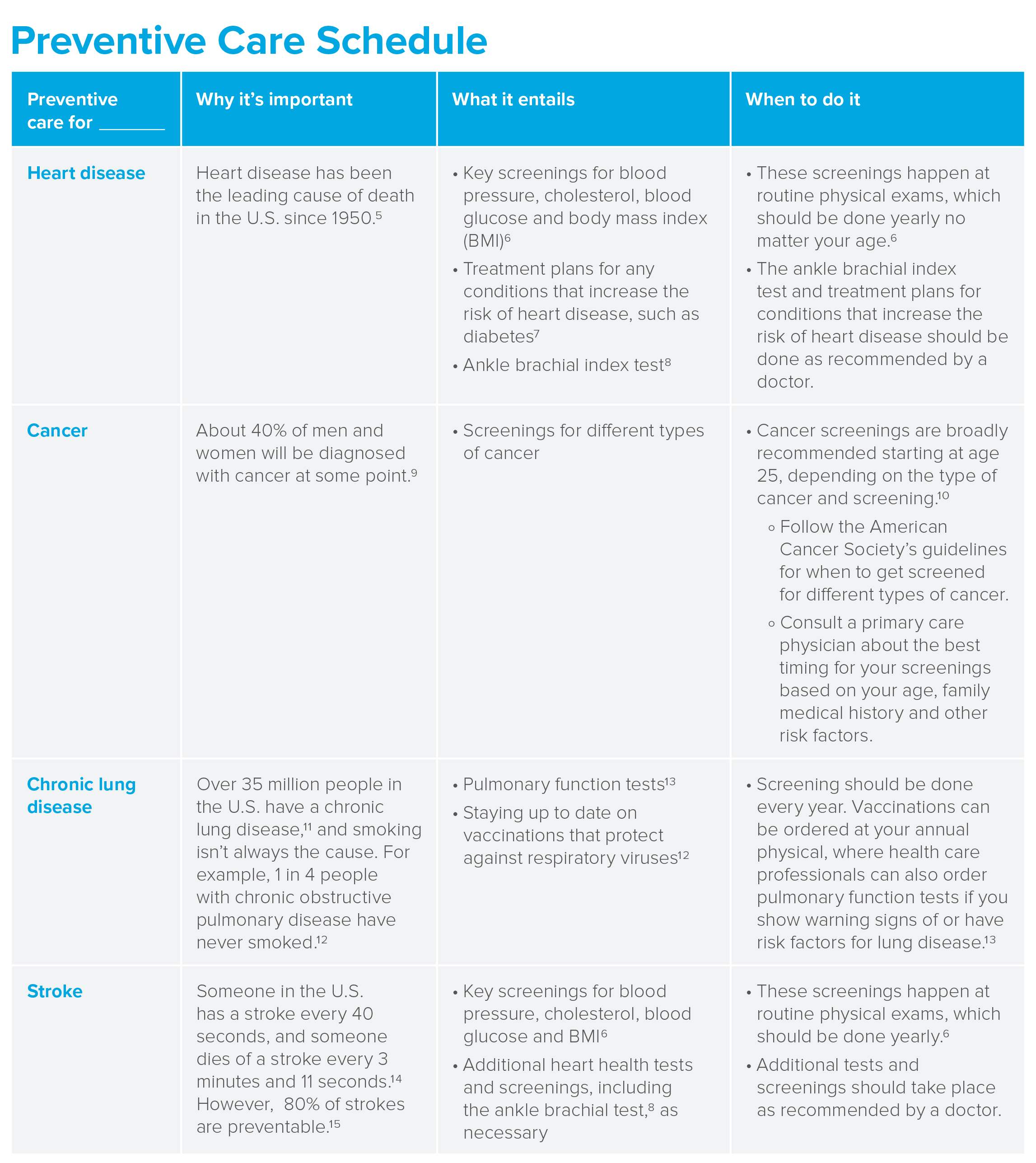It’s better to regularly monitor and replace your car’s tires than to tend to them only when you get a flat. Just like it’s better to get a screen protector for your new phone right away instead of after the display is cracked. Really, it’s advantageous to be proactive instead of reactive in just about every area of your life, especially your health. Because the old adage still holds true: Prevention is the best medicine.
Of course, prevention only works if it’s timely — and unfortunately, most people are behind on their preventive care. In fact, nearly 70% of U.S. adults report being behind on at least one recommended preventive care screening.1
There are many factors that contribute to this problem, including lack of information. But no matter the cause, forgoing preventive care can lead to negative consequences for your employees and your organization.
Keep reading to learn why preventive care is so helpful for employees and employers. Then share the chart below with your staff to arm them with the information they need to seek out the most important screenings.
The importance of preventive health care: Why it’s the best medicine
Preventive care saves and extends lives. Health screenings and primary care consultations are found to significantly increase life expectancy, especially among 30- to 49-year-olds. Routine cardiovascular exams alone save tens of thousands of lives every year.2
Preventive care saves money, too, for employers and employees alike. For example, health-related productivity issues cost employers $530 billion per year.3 That’s why it’s in an employer’s best interest to prioritize their employees’ health and encourage them to pursue preventive care.
This approach to care, including leading a healthy lifestyle and going for regular wellness visits and screenings, can help catch precursors to disease early on, before symptoms even develop. That can make it easier to prevent serious diseases (or keep them from worsening, if detected early), which in turn means that employers and employees spend less on health care.
How to practice proper preventive care
Preventive care works — but only if you do it. And according to the most recent data from the federal Healthy People 2030 initiative, only 5.3% of U.S. adults age 35 and older have received all recommended high-priority clinical preventive services.4 So, in addition to providing benefits packages that make screenings and other preventive care financially accessible, businesses should urge their employees to stay on top of their preventive care schedule.
Sharing the following chart is a great place to start.

Want to combine this information with benefits that make preventive care more financially accessible for your employees? Contact your Aflac benefits advisor or visit Aflac.com/business.
Companies choose to make Aflac policies available to increase benefits options without impacting their bottom line.
1 Prevent Cancer Foundation. “U.S. adults are still behind on routine cancer screenings—but reasons why vary by race.” Published 4.1.2024. Accessed 7.15.25.
2 PublicHealth.org. “Preventive Care.” Accessed 7.15.25.
3 Association of Health Care Journalists. “Poor Health Costs US Employers $530 Billion and 1.4 Billion Work Days of Absence and Impaired Performance.” Accessed 7.15.25.
4 Healthy People 2030. “Increase the proportion of adults who get recommended evidence-based preventive health care — AHS-08.” Accessed 7.15.25.
5 Centers for Disease Control and Prevention. “Heart Disease Deaths.” Reviewed 8.5.2024. Accessed 7.15.25.
6 American Heart Association. “Heart-Health Screenings.” Reviewed 1.16.2024. Accessed 7.15.25.
7 Centers for Disease Control and Prevention. “Heart Disease Risk Factors.” Published 5.15.2024. Accessed 7.15.25.
8 WebMD. “Ankle-Brachial Index (ABI) Test.” Reviewed 2.12.2024. Accessed 7.15.25.
9 National Cancer Institute. “Cancer Statistics.” Updated 5.7.2025. Accessed 7.15.25.
10 American Cancer Society. “Cancer Screening Guidelines by Age” Published 2023. Accessed 7.15.25.
11 American Lung Association. “Our Impact.” Updated 9.16.2024. Accessed 7.15.25.
12 American Lung Association. “COPD Causes and Risk Factors.” Updated 3.19.25. Accessed 7.15.25.
13American Lung Association. “Pulmonary Function Tests.” Updated 5.12.25. Accessed 7.15.25.
14 Centers for Disease Control and Prevention. “Stroke Facts.” Published 10.24.2024. Accessed 7.15.25.
15 American Stroke Association. “Prevention.” Accessed 7.15.25.
Continental American Insurance Company (CAIC), a proud member of the Aflac family of insurers, is a wholly-owned subsidiary of Aflac Incorporated and underwrites group coverage. CAIC is not licensed to solicit business in New York, Guam, Puerto Rico, or the Virgin Islands. For groups sitused in California, group coverage is underwritten by Continental American Life Insurance Company. For groups sitused in New York, coverage is underwritten by Aflac of New York.
Continental American Insurance Company |Columbia, South Carolina | 1-800-433-3036
Aflac New York | 22 Corporate Woods Boulevard, Suite 2 | Albany, NY 12211
AGC2401607R1
EXP 9/26